Marketing Principles: An Analysis of Coca-Cola's Marketing Approach
VerifiedAdded on 2019/10/31
|20
|4383
|196
Report
AI Summary
This report provides a comprehensive analysis of Coca-Cola's marketing strategies, examining its micro and macro environmental factors, including customers, competitors, and the SWOT analysis. It delves into Coca-Cola's marketing mix, including product, place, price, and promotion. The report also explores the company's segmentation, targeting, and differentiation strategies, alongside its brand positioning. Furthermore, the report investigates the macro-environmental factors in Australia, providing insights into political, economic, and socio-cultural influences. The report concludes with recommendations for Coca-Cola's future marketing endeavors and evaluates the effectiveness of its current strategies, offering a detailed overview of its market approach and competitive positioning.
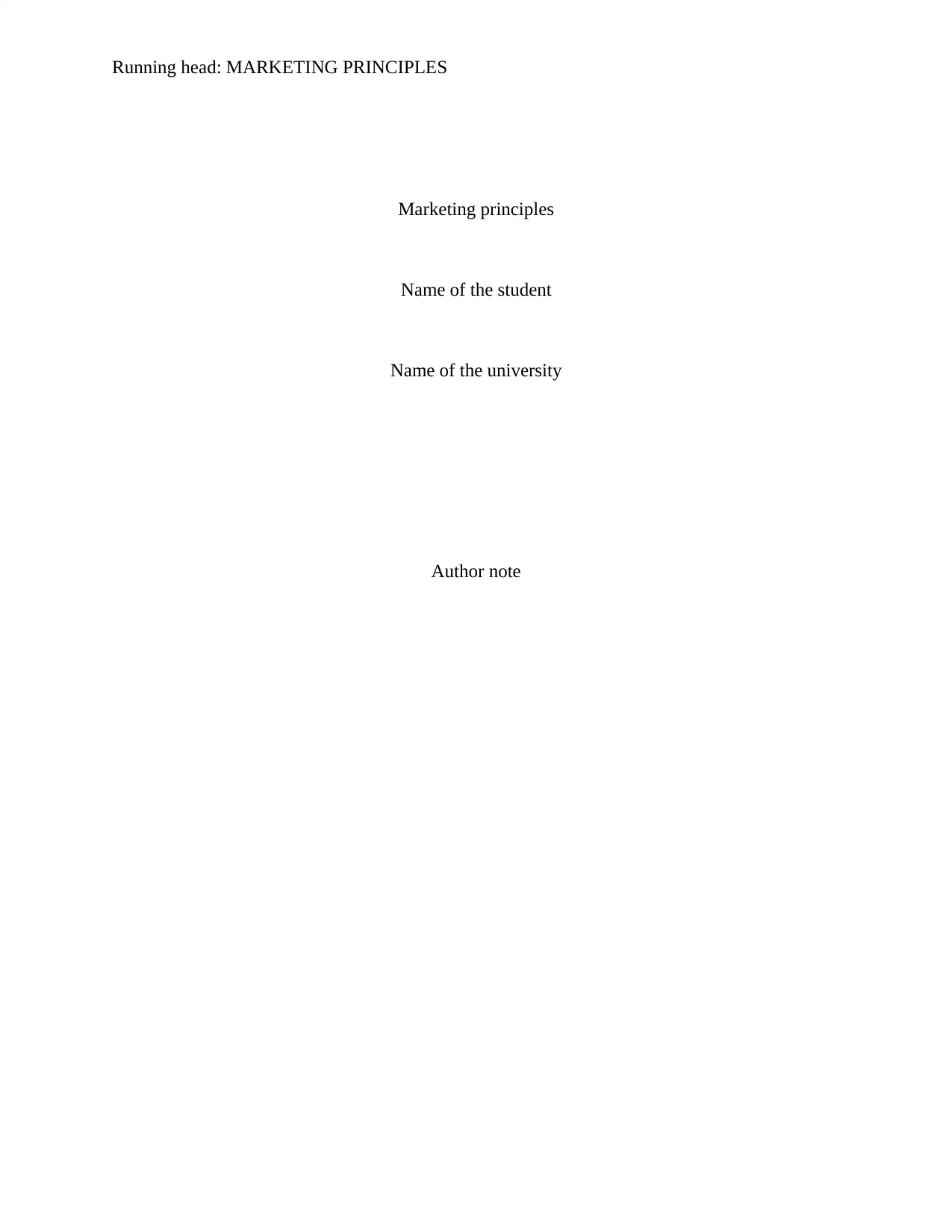
Running head: MARKETING PRINCIPLES
Marketing principles
Name of the student
Name of the university
Author note
Marketing principles
Name of the student
Name of the university
Author note
Paraphrase This Document
Need a fresh take? Get an instant paraphrase of this document with our AI Paraphraser
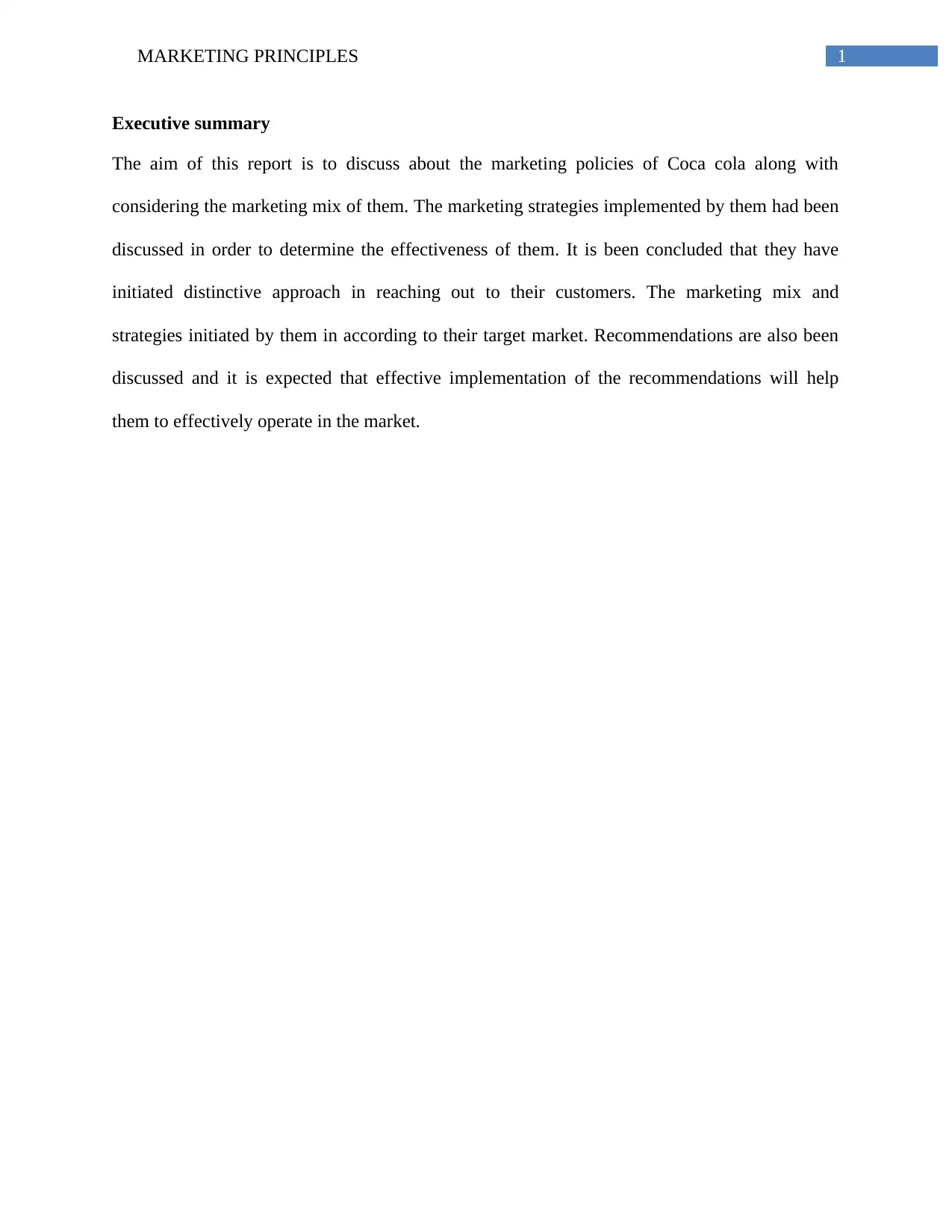
1MARKETING PRINCIPLES
Executive summary
The aim of this report is to discuss about the marketing policies of Coca cola along with
considering the marketing mix of them. The marketing strategies implemented by them had been
discussed in order to determine the effectiveness of them. It is been concluded that they have
initiated distinctive approach in reaching out to their customers. The marketing mix and
strategies initiated by them in according to their target market. Recommendations are also been
discussed and it is expected that effective implementation of the recommendations will help
them to effectively operate in the market.
Executive summary
The aim of this report is to discuss about the marketing policies of Coca cola along with
considering the marketing mix of them. The marketing strategies implemented by them had been
discussed in order to determine the effectiveness of them. It is been concluded that they have
initiated distinctive approach in reaching out to their customers. The marketing mix and
strategies initiated by them in according to their target market. Recommendations are also been
discussed and it is expected that effective implementation of the recommendations will help
them to effectively operate in the market.
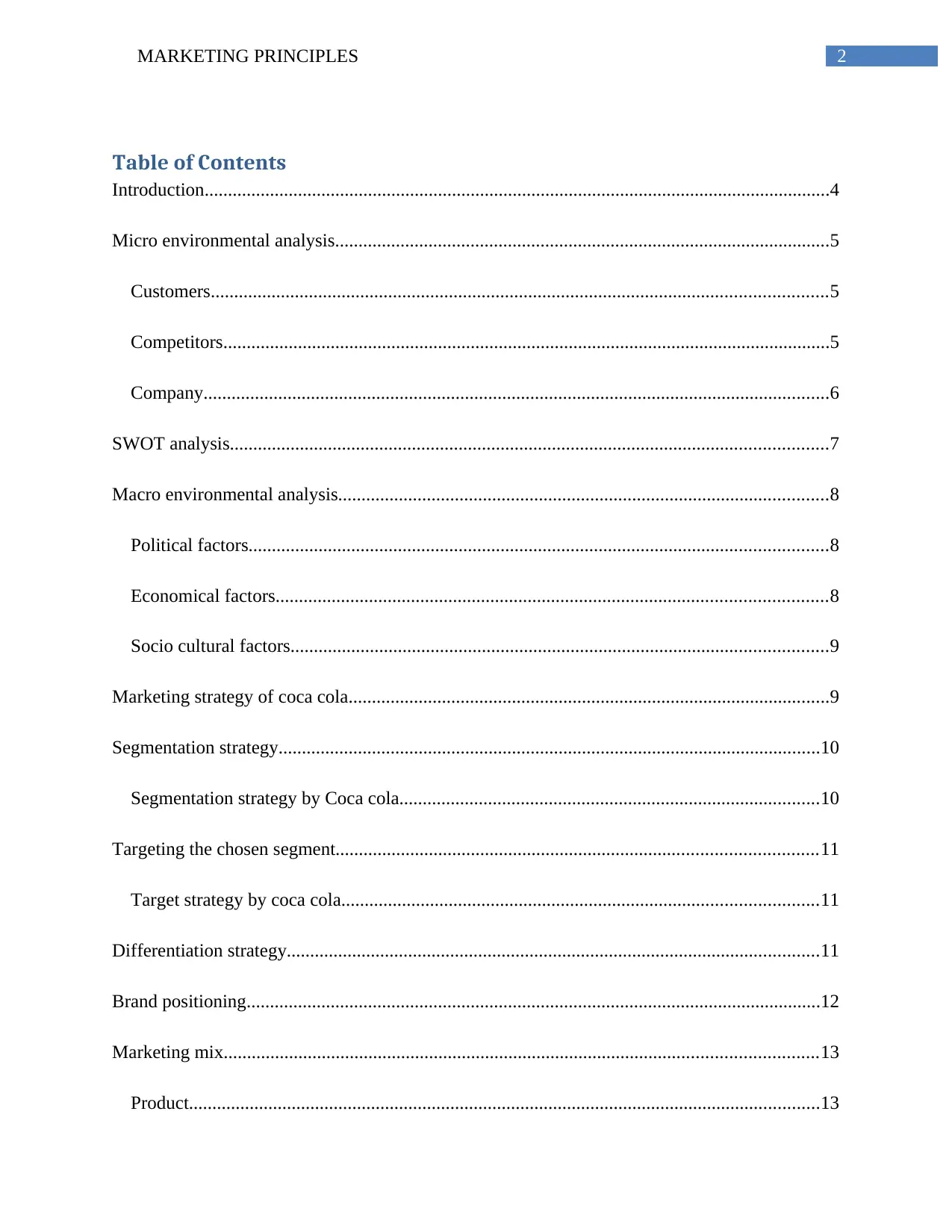
2MARKETING PRINCIPLES
Table of Contents
Introduction......................................................................................................................................4
Micro environmental analysis..........................................................................................................5
Customers....................................................................................................................................5
Competitors..................................................................................................................................5
Company......................................................................................................................................6
SWOT analysis................................................................................................................................7
Macro environmental analysis.........................................................................................................8
Political factors............................................................................................................................8
Economical factors......................................................................................................................8
Socio cultural factors...................................................................................................................9
Marketing strategy of coca cola.......................................................................................................9
Segmentation strategy....................................................................................................................10
Segmentation strategy by Coca cola..........................................................................................10
Targeting the chosen segment.......................................................................................................11
Target strategy by coca cola......................................................................................................11
Differentiation strategy..................................................................................................................11
Brand positioning...........................................................................................................................12
Marketing mix...............................................................................................................................13
Product.......................................................................................................................................13
Table of Contents
Introduction......................................................................................................................................4
Micro environmental analysis..........................................................................................................5
Customers....................................................................................................................................5
Competitors..................................................................................................................................5
Company......................................................................................................................................6
SWOT analysis................................................................................................................................7
Macro environmental analysis.........................................................................................................8
Political factors............................................................................................................................8
Economical factors......................................................................................................................8
Socio cultural factors...................................................................................................................9
Marketing strategy of coca cola.......................................................................................................9
Segmentation strategy....................................................................................................................10
Segmentation strategy by Coca cola..........................................................................................10
Targeting the chosen segment.......................................................................................................11
Target strategy by coca cola......................................................................................................11
Differentiation strategy..................................................................................................................11
Brand positioning...........................................................................................................................12
Marketing mix...............................................................................................................................13
Product.......................................................................................................................................13
⊘ This is a preview!⊘
Do you want full access?
Subscribe today to unlock all pages.

Trusted by 1+ million students worldwide
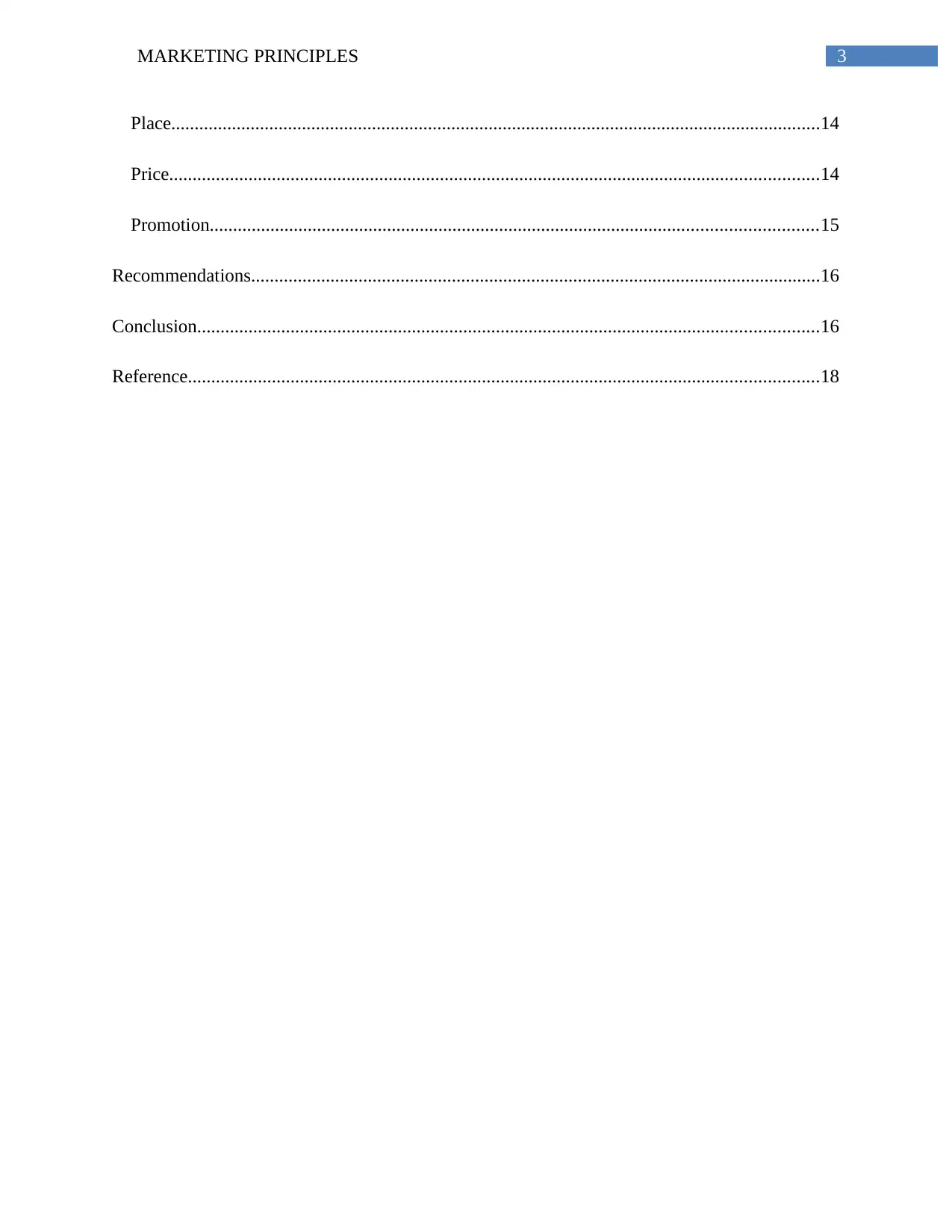
3MARKETING PRINCIPLES
Place...........................................................................................................................................14
Price...........................................................................................................................................14
Promotion..................................................................................................................................15
Recommendations..........................................................................................................................16
Conclusion.....................................................................................................................................16
Reference.......................................................................................................................................18
Place...........................................................................................................................................14
Price...........................................................................................................................................14
Promotion..................................................................................................................................15
Recommendations..........................................................................................................................16
Conclusion.....................................................................................................................................16
Reference.......................................................................................................................................18
Paraphrase This Document
Need a fresh take? Get an instant paraphrase of this document with our AI Paraphraser
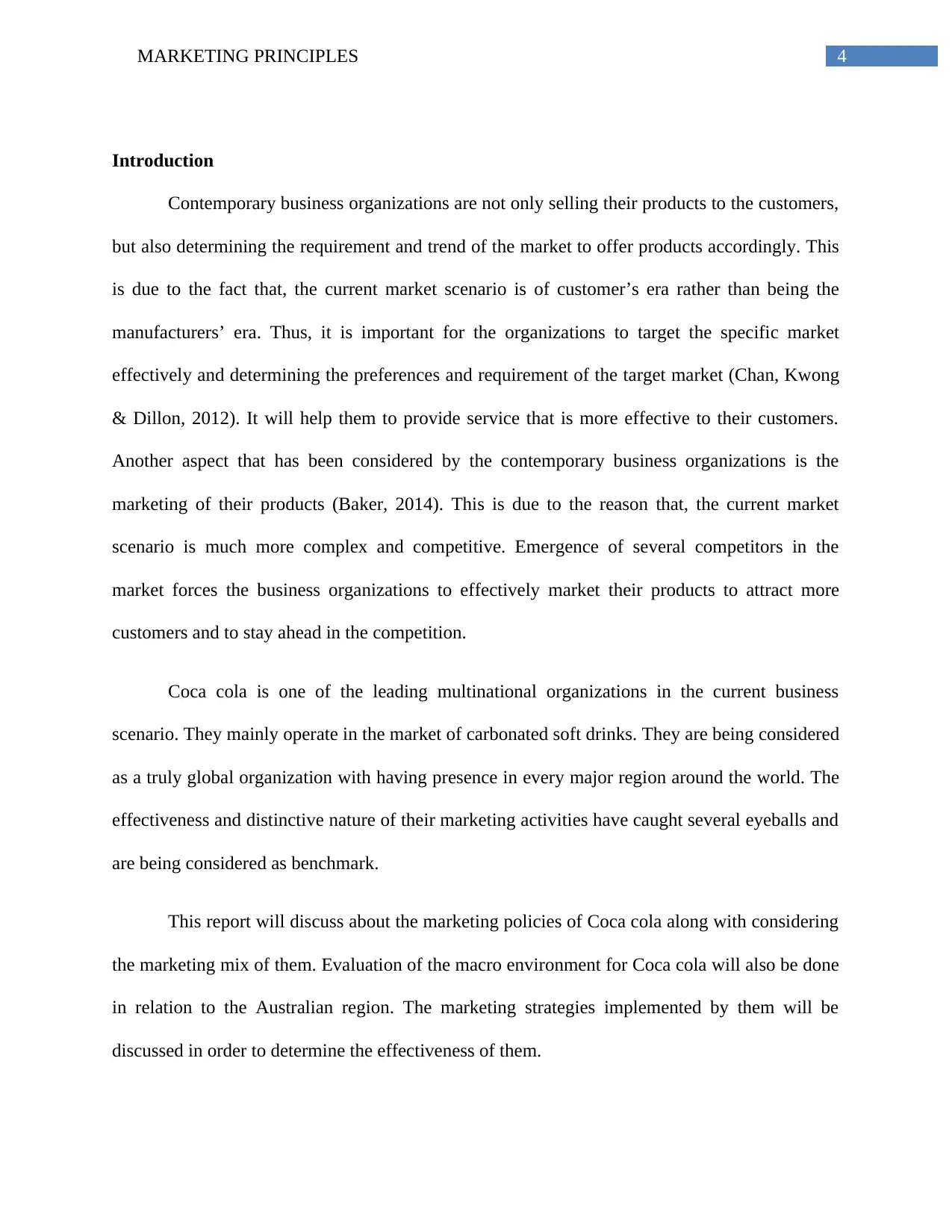
4MARKETING PRINCIPLES
Introduction
Contemporary business organizations are not only selling their products to the customers,
but also determining the requirement and trend of the market to offer products accordingly. This
is due to the fact that, the current market scenario is of customer’s era rather than being the
manufacturers’ era. Thus, it is important for the organizations to target the specific market
effectively and determining the preferences and requirement of the target market (Chan, Kwong
& Dillon, 2012). It will help them to provide service that is more effective to their customers.
Another aspect that has been considered by the contemporary business organizations is the
marketing of their products (Baker, 2014). This is due to the reason that, the current market
scenario is much more complex and competitive. Emergence of several competitors in the
market forces the business organizations to effectively market their products to attract more
customers and to stay ahead in the competition.
Coca cola is one of the leading multinational organizations in the current business
scenario. They mainly operate in the market of carbonated soft drinks. They are being considered
as a truly global organization with having presence in every major region around the world. The
effectiveness and distinctive nature of their marketing activities have caught several eyeballs and
are being considered as benchmark.
This report will discuss about the marketing policies of Coca cola along with considering
the marketing mix of them. Evaluation of the macro environment for Coca cola will also be done
in relation to the Australian region. The marketing strategies implemented by them will be
discussed in order to determine the effectiveness of them.
Introduction
Contemporary business organizations are not only selling their products to the customers,
but also determining the requirement and trend of the market to offer products accordingly. This
is due to the fact that, the current market scenario is of customer’s era rather than being the
manufacturers’ era. Thus, it is important for the organizations to target the specific market
effectively and determining the preferences and requirement of the target market (Chan, Kwong
& Dillon, 2012). It will help them to provide service that is more effective to their customers.
Another aspect that has been considered by the contemporary business organizations is the
marketing of their products (Baker, 2014). This is due to the reason that, the current market
scenario is much more complex and competitive. Emergence of several competitors in the
market forces the business organizations to effectively market their products to attract more
customers and to stay ahead in the competition.
Coca cola is one of the leading multinational organizations in the current business
scenario. They mainly operate in the market of carbonated soft drinks. They are being considered
as a truly global organization with having presence in every major region around the world. The
effectiveness and distinctive nature of their marketing activities have caught several eyeballs and
are being considered as benchmark.
This report will discuss about the marketing policies of Coca cola along with considering
the marketing mix of them. Evaluation of the macro environment for Coca cola will also be done
in relation to the Australian region. The marketing strategies implemented by them will be
discussed in order to determine the effectiveness of them.
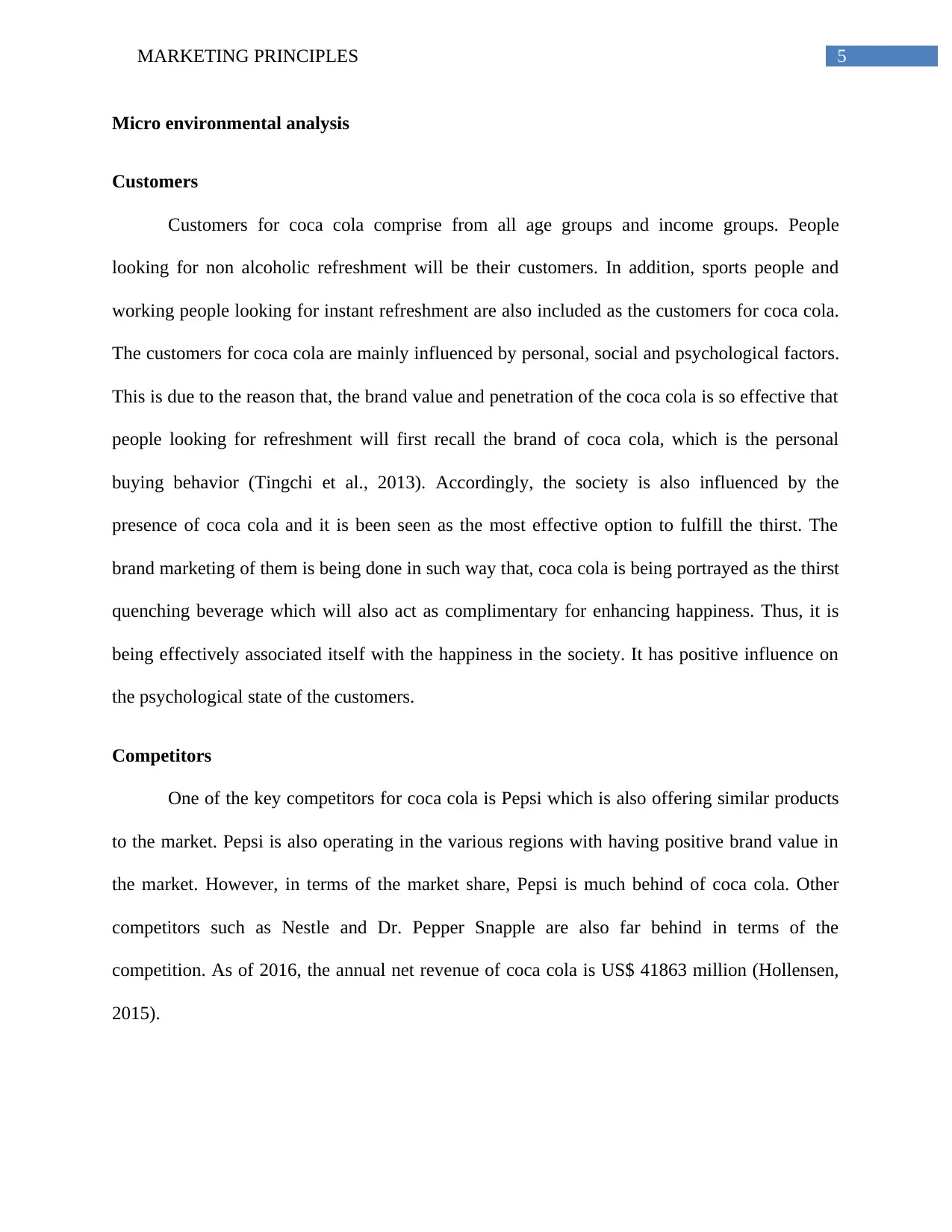
5MARKETING PRINCIPLES
Micro environmental analysis
Customers
Customers for coca cola comprise from all age groups and income groups. People
looking for non alcoholic refreshment will be their customers. In addition, sports people and
working people looking for instant refreshment are also included as the customers for coca cola.
The customers for coca cola are mainly influenced by personal, social and psychological factors.
This is due to the reason that, the brand value and penetration of the coca cola is so effective that
people looking for refreshment will first recall the brand of coca cola, which is the personal
buying behavior (Tingchi et al., 2013). Accordingly, the society is also influenced by the
presence of coca cola and it is been seen as the most effective option to fulfill the thirst. The
brand marketing of them is being done in such way that, coca cola is being portrayed as the thirst
quenching beverage which will also act as complimentary for enhancing happiness. Thus, it is
being effectively associated itself with the happiness in the society. It has positive influence on
the psychological state of the customers.
Competitors
One of the key competitors for coca cola is Pepsi which is also offering similar products
to the market. Pepsi is also operating in the various regions with having positive brand value in
the market. However, in terms of the market share, Pepsi is much behind of coca cola. Other
competitors such as Nestle and Dr. Pepper Snapple are also far behind in terms of the
competition. As of 2016, the annual net revenue of coca cola is US$ 41863 million (Hollensen,
2015).
Micro environmental analysis
Customers
Customers for coca cola comprise from all age groups and income groups. People
looking for non alcoholic refreshment will be their customers. In addition, sports people and
working people looking for instant refreshment are also included as the customers for coca cola.
The customers for coca cola are mainly influenced by personal, social and psychological factors.
This is due to the reason that, the brand value and penetration of the coca cola is so effective that
people looking for refreshment will first recall the brand of coca cola, which is the personal
buying behavior (Tingchi et al., 2013). Accordingly, the society is also influenced by the
presence of coca cola and it is been seen as the most effective option to fulfill the thirst. The
brand marketing of them is being done in such way that, coca cola is being portrayed as the thirst
quenching beverage which will also act as complimentary for enhancing happiness. Thus, it is
being effectively associated itself with the happiness in the society. It has positive influence on
the psychological state of the customers.
Competitors
One of the key competitors for coca cola is Pepsi which is also offering similar products
to the market. Pepsi is also operating in the various regions with having positive brand value in
the market. However, in terms of the market share, Pepsi is much behind of coca cola. Other
competitors such as Nestle and Dr. Pepper Snapple are also far behind in terms of the
competition. As of 2016, the annual net revenue of coca cola is US$ 41863 million (Hollensen,
2015).
⊘ This is a preview!⊘
Do you want full access?
Subscribe today to unlock all pages.

Trusted by 1+ million students worldwide
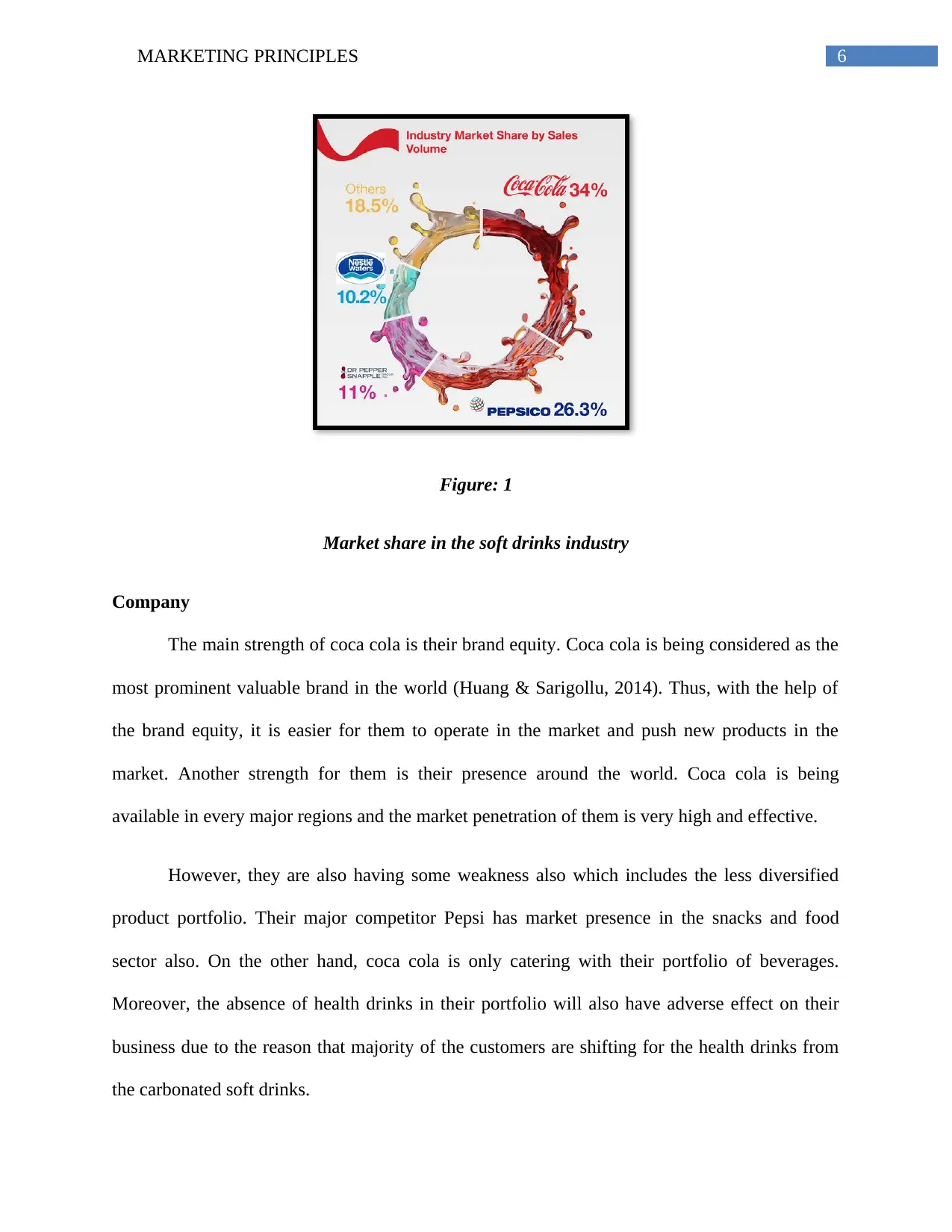
6MARKETING PRINCIPLES
Figure: 1
Market share in the soft drinks industry
Company
The main strength of coca cola is their brand equity. Coca cola is being considered as the
most prominent valuable brand in the world (Huang & Sarigollu, 2014). Thus, with the help of
the brand equity, it is easier for them to operate in the market and push new products in the
market. Another strength for them is their presence around the world. Coca cola is being
available in every major regions and the market penetration of them is very high and effective.
However, they are also having some weakness also which includes the less diversified
product portfolio. Their major competitor Pepsi has market presence in the snacks and food
sector also. On the other hand, coca cola is only catering with their portfolio of beverages.
Moreover, the absence of health drinks in their portfolio will also have adverse effect on their
business due to the reason that majority of the customers are shifting for the health drinks from
the carbonated soft drinks.
Figure: 1
Market share in the soft drinks industry
Company
The main strength of coca cola is their brand equity. Coca cola is being considered as the
most prominent valuable brand in the world (Huang & Sarigollu, 2014). Thus, with the help of
the brand equity, it is easier for them to operate in the market and push new products in the
market. Another strength for them is their presence around the world. Coca cola is being
available in every major regions and the market penetration of them is very high and effective.
However, they are also having some weakness also which includes the less diversified
product portfolio. Their major competitor Pepsi has market presence in the snacks and food
sector also. On the other hand, coca cola is only catering with their portfolio of beverages.
Moreover, the absence of health drinks in their portfolio will also have adverse effect on their
business due to the reason that majority of the customers are shifting for the health drinks from
the carbonated soft drinks.
Paraphrase This Document
Need a fresh take? Get an instant paraphrase of this document with our AI Paraphraser
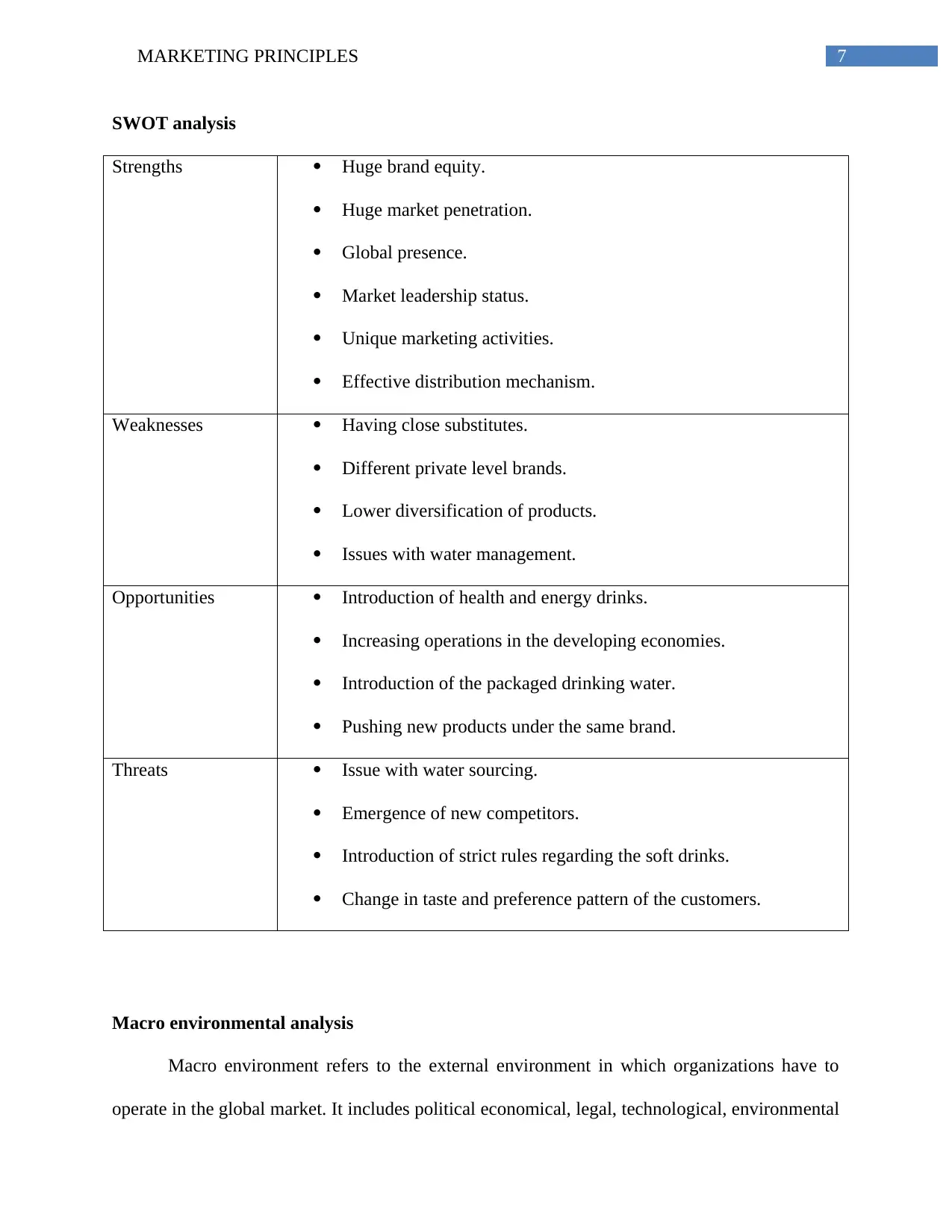
7MARKETING PRINCIPLES
SWOT analysis
Strengths Huge brand equity.
Huge market penetration.
Global presence.
Market leadership status.
Unique marketing activities.
Effective distribution mechanism.
Weaknesses Having close substitutes.
Different private level brands.
Lower diversification of products.
Issues with water management.
Opportunities Introduction of health and energy drinks.
Increasing operations in the developing economies.
Introduction of the packaged drinking water.
Pushing new products under the same brand.
Threats Issue with water sourcing.
Emergence of new competitors.
Introduction of strict rules regarding the soft drinks.
Change in taste and preference pattern of the customers.
Macro environmental analysis
Macro environment refers to the external environment in which organizations have to
operate in the global market. It includes political economical, legal, technological, environmental
SWOT analysis
Strengths Huge brand equity.
Huge market penetration.
Global presence.
Market leadership status.
Unique marketing activities.
Effective distribution mechanism.
Weaknesses Having close substitutes.
Different private level brands.
Lower diversification of products.
Issues with water management.
Opportunities Introduction of health and energy drinks.
Increasing operations in the developing economies.
Introduction of the packaged drinking water.
Pushing new products under the same brand.
Threats Issue with water sourcing.
Emergence of new competitors.
Introduction of strict rules regarding the soft drinks.
Change in taste and preference pattern of the customers.
Macro environmental analysis
Macro environment refers to the external environment in which organizations have to
operate in the global market. It includes political economical, legal, technological, environmental
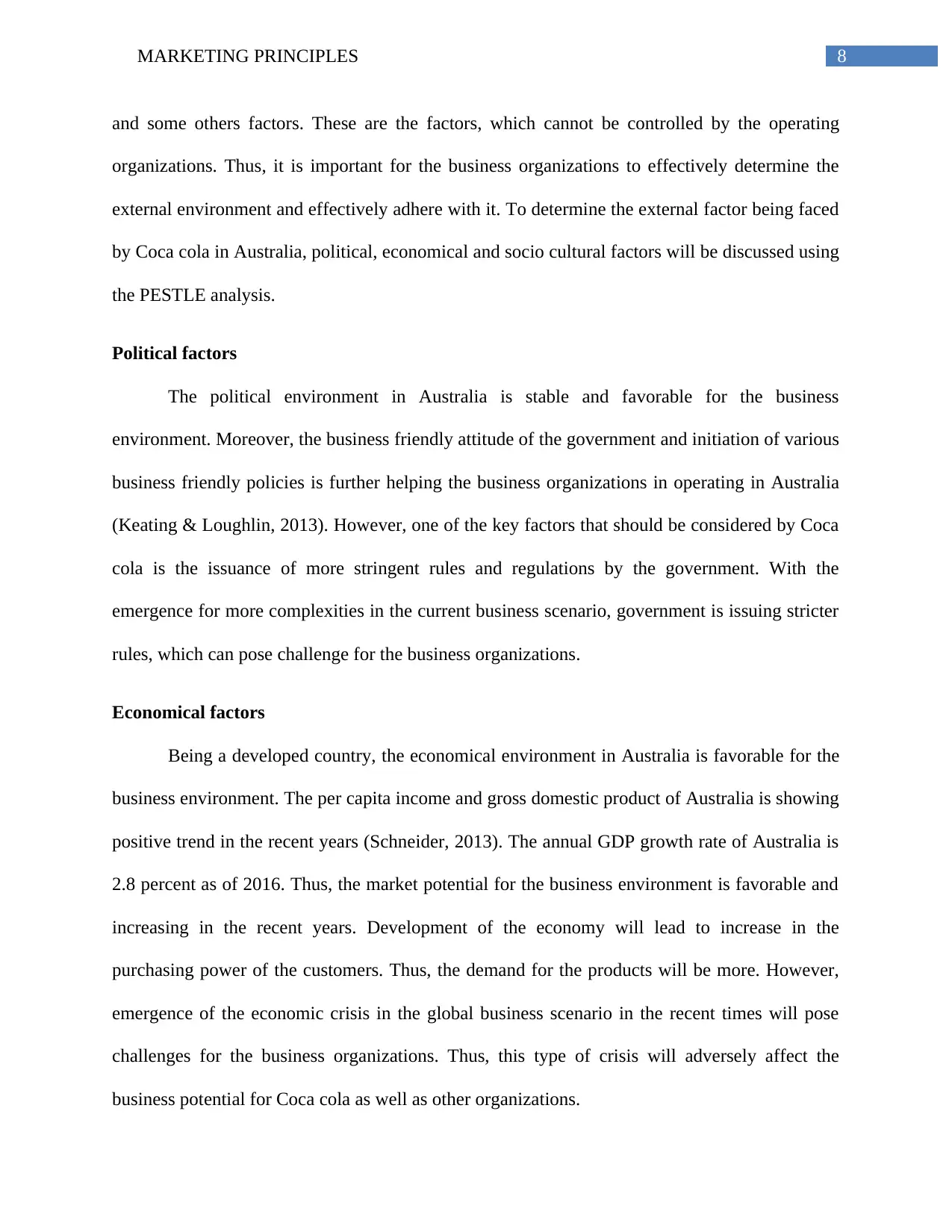
8MARKETING PRINCIPLES
and some others factors. These are the factors, which cannot be controlled by the operating
organizations. Thus, it is important for the business organizations to effectively determine the
external environment and effectively adhere with it. To determine the external factor being faced
by Coca cola in Australia, political, economical and socio cultural factors will be discussed using
the PESTLE analysis.
Political factors
The political environment in Australia is stable and favorable for the business
environment. Moreover, the business friendly attitude of the government and initiation of various
business friendly policies is further helping the business organizations in operating in Australia
(Keating & Loughlin, 2013). However, one of the key factors that should be considered by Coca
cola is the issuance of more stringent rules and regulations by the government. With the
emergence for more complexities in the current business scenario, government is issuing stricter
rules, which can pose challenge for the business organizations.
Economical factors
Being a developed country, the economical environment in Australia is favorable for the
business environment. The per capita income and gross domestic product of Australia is showing
positive trend in the recent years (Schneider, 2013). The annual GDP growth rate of Australia is
2.8 percent as of 2016. Thus, the market potential for the business environment is favorable and
increasing in the recent years. Development of the economy will lead to increase in the
purchasing power of the customers. Thus, the demand for the products will be more. However,
emergence of the economic crisis in the global business scenario in the recent times will pose
challenges for the business organizations. Thus, this type of crisis will adversely affect the
business potential for Coca cola as well as other organizations.
and some others factors. These are the factors, which cannot be controlled by the operating
organizations. Thus, it is important for the business organizations to effectively determine the
external environment and effectively adhere with it. To determine the external factor being faced
by Coca cola in Australia, political, economical and socio cultural factors will be discussed using
the PESTLE analysis.
Political factors
The political environment in Australia is stable and favorable for the business
environment. Moreover, the business friendly attitude of the government and initiation of various
business friendly policies is further helping the business organizations in operating in Australia
(Keating & Loughlin, 2013). However, one of the key factors that should be considered by Coca
cola is the issuance of more stringent rules and regulations by the government. With the
emergence for more complexities in the current business scenario, government is issuing stricter
rules, which can pose challenge for the business organizations.
Economical factors
Being a developed country, the economical environment in Australia is favorable for the
business environment. The per capita income and gross domestic product of Australia is showing
positive trend in the recent years (Schneider, 2013). The annual GDP growth rate of Australia is
2.8 percent as of 2016. Thus, the market potential for the business environment is favorable and
increasing in the recent years. Development of the economy will lead to increase in the
purchasing power of the customers. Thus, the demand for the products will be more. However,
emergence of the economic crisis in the global business scenario in the recent times will pose
challenges for the business organizations. Thus, this type of crisis will adversely affect the
business potential for Coca cola as well as other organizations.
⊘ This is a preview!⊘
Do you want full access?
Subscribe today to unlock all pages.

Trusted by 1+ million students worldwide
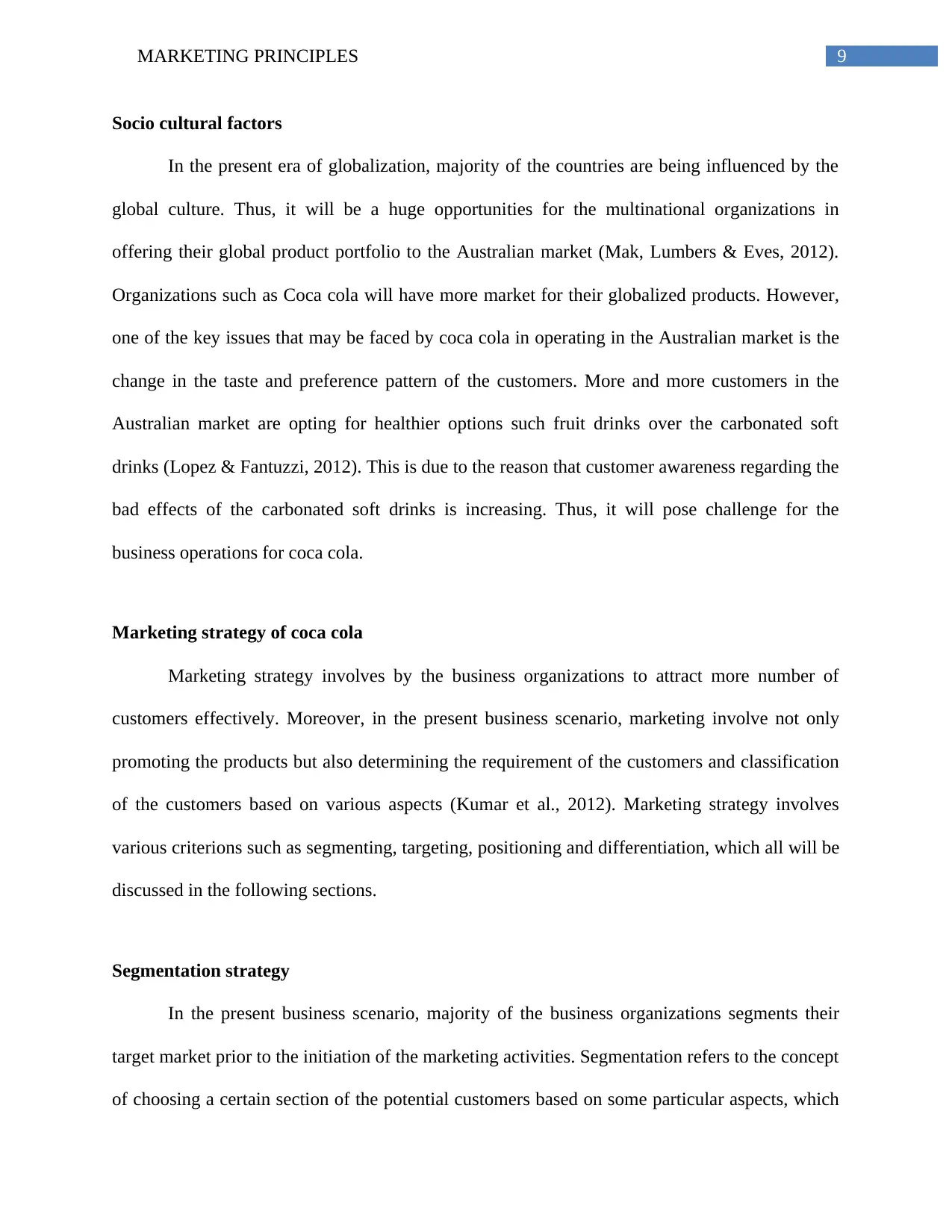
9MARKETING PRINCIPLES
Socio cultural factors
In the present era of globalization, majority of the countries are being influenced by the
global culture. Thus, it will be a huge opportunities for the multinational organizations in
offering their global product portfolio to the Australian market (Mak, Lumbers & Eves, 2012).
Organizations such as Coca cola will have more market for their globalized products. However,
one of the key issues that may be faced by coca cola in operating in the Australian market is the
change in the taste and preference pattern of the customers. More and more customers in the
Australian market are opting for healthier options such fruit drinks over the carbonated soft
drinks (Lopez & Fantuzzi, 2012). This is due to the reason that customer awareness regarding the
bad effects of the carbonated soft drinks is increasing. Thus, it will pose challenge for the
business operations for coca cola.
Marketing strategy of coca cola
Marketing strategy involves by the business organizations to attract more number of
customers effectively. Moreover, in the present business scenario, marketing involve not only
promoting the products but also determining the requirement of the customers and classification
of the customers based on various aspects (Kumar et al., 2012). Marketing strategy involves
various criterions such as segmenting, targeting, positioning and differentiation, which all will be
discussed in the following sections.
Segmentation strategy
In the present business scenario, majority of the business organizations segments their
target market prior to the initiation of the marketing activities. Segmentation refers to the concept
of choosing a certain section of the potential customers based on some particular aspects, which
Socio cultural factors
In the present era of globalization, majority of the countries are being influenced by the
global culture. Thus, it will be a huge opportunities for the multinational organizations in
offering their global product portfolio to the Australian market (Mak, Lumbers & Eves, 2012).
Organizations such as Coca cola will have more market for their globalized products. However,
one of the key issues that may be faced by coca cola in operating in the Australian market is the
change in the taste and preference pattern of the customers. More and more customers in the
Australian market are opting for healthier options such fruit drinks over the carbonated soft
drinks (Lopez & Fantuzzi, 2012). This is due to the reason that customer awareness regarding the
bad effects of the carbonated soft drinks is increasing. Thus, it will pose challenge for the
business operations for coca cola.
Marketing strategy of coca cola
Marketing strategy involves by the business organizations to attract more number of
customers effectively. Moreover, in the present business scenario, marketing involve not only
promoting the products but also determining the requirement of the customers and classification
of the customers based on various aspects (Kumar et al., 2012). Marketing strategy involves
various criterions such as segmenting, targeting, positioning and differentiation, which all will be
discussed in the following sections.
Segmentation strategy
In the present business scenario, majority of the business organizations segments their
target market prior to the initiation of the marketing activities. Segmentation refers to the concept
of choosing a certain section of the potential customers based on some particular aspects, which
Paraphrase This Document
Need a fresh take? Get an instant paraphrase of this document with our AI Paraphraser
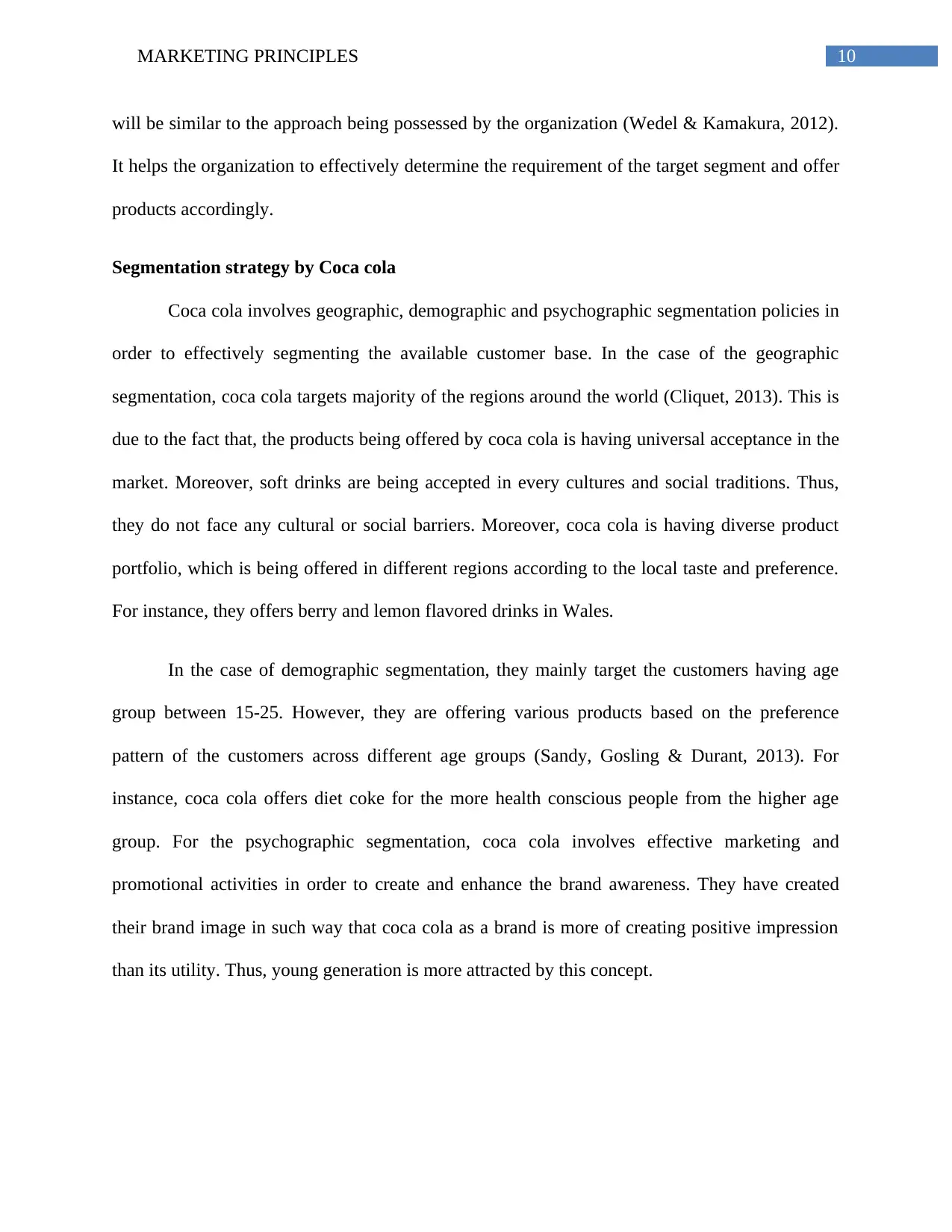
10MARKETING PRINCIPLES
will be similar to the approach being possessed by the organization (Wedel & Kamakura, 2012).
It helps the organization to effectively determine the requirement of the target segment and offer
products accordingly.
Segmentation strategy by Coca cola
Coca cola involves geographic, demographic and psychographic segmentation policies in
order to effectively segmenting the available customer base. In the case of the geographic
segmentation, coca cola targets majority of the regions around the world (Cliquet, 2013). This is
due to the fact that, the products being offered by coca cola is having universal acceptance in the
market. Moreover, soft drinks are being accepted in every cultures and social traditions. Thus,
they do not face any cultural or social barriers. Moreover, coca cola is having diverse product
portfolio, which is being offered in different regions according to the local taste and preference.
For instance, they offers berry and lemon flavored drinks in Wales.
In the case of demographic segmentation, they mainly target the customers having age
group between 15-25. However, they are offering various products based on the preference
pattern of the customers across different age groups (Sandy, Gosling & Durant, 2013). For
instance, coca cola offers diet coke for the more health conscious people from the higher age
group. For the psychographic segmentation, coca cola involves effective marketing and
promotional activities in order to create and enhance the brand awareness. They have created
their brand image in such way that coca cola as a brand is more of creating positive impression
than its utility. Thus, young generation is more attracted by this concept.
will be similar to the approach being possessed by the organization (Wedel & Kamakura, 2012).
It helps the organization to effectively determine the requirement of the target segment and offer
products accordingly.
Segmentation strategy by Coca cola
Coca cola involves geographic, demographic and psychographic segmentation policies in
order to effectively segmenting the available customer base. In the case of the geographic
segmentation, coca cola targets majority of the regions around the world (Cliquet, 2013). This is
due to the fact that, the products being offered by coca cola is having universal acceptance in the
market. Moreover, soft drinks are being accepted in every cultures and social traditions. Thus,
they do not face any cultural or social barriers. Moreover, coca cola is having diverse product
portfolio, which is being offered in different regions according to the local taste and preference.
For instance, they offers berry and lemon flavored drinks in Wales.
In the case of demographic segmentation, they mainly target the customers having age
group between 15-25. However, they are offering various products based on the preference
pattern of the customers across different age groups (Sandy, Gosling & Durant, 2013). For
instance, coca cola offers diet coke for the more health conscious people from the higher age
group. For the psychographic segmentation, coca cola involves effective marketing and
promotional activities in order to create and enhance the brand awareness. They have created
their brand image in such way that coca cola as a brand is more of creating positive impression
than its utility. Thus, young generation is more attracted by this concept.
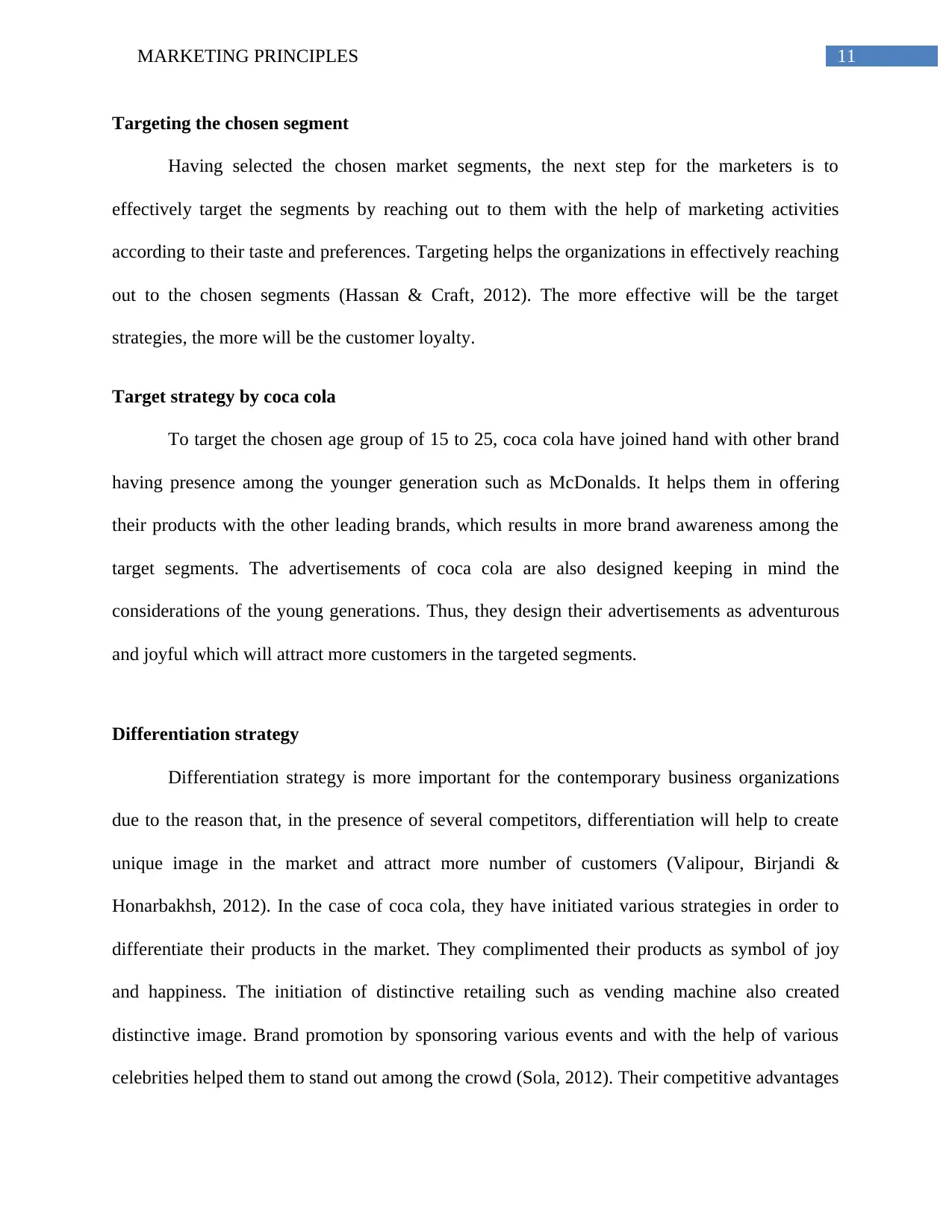
11MARKETING PRINCIPLES
Targeting the chosen segment
Having selected the chosen market segments, the next step for the marketers is to
effectively target the segments by reaching out to them with the help of marketing activities
according to their taste and preferences. Targeting helps the organizations in effectively reaching
out to the chosen segments (Hassan & Craft, 2012). The more effective will be the target
strategies, the more will be the customer loyalty.
Target strategy by coca cola
To target the chosen age group of 15 to 25, coca cola have joined hand with other brand
having presence among the younger generation such as McDonalds. It helps them in offering
their products with the other leading brands, which results in more brand awareness among the
target segments. The advertisements of coca cola are also designed keeping in mind the
considerations of the young generations. Thus, they design their advertisements as adventurous
and joyful which will attract more customers in the targeted segments.
Differentiation strategy
Differentiation strategy is more important for the contemporary business organizations
due to the reason that, in the presence of several competitors, differentiation will help to create
unique image in the market and attract more number of customers (Valipour, Birjandi &
Honarbakhsh, 2012). In the case of coca cola, they have initiated various strategies in order to
differentiate their products in the market. They complimented their products as symbol of joy
and happiness. The initiation of distinctive retailing such as vending machine also created
distinctive image. Brand promotion by sponsoring various events and with the help of various
celebrities helped them to stand out among the crowd (Sola, 2012). Their competitive advantages
Targeting the chosen segment
Having selected the chosen market segments, the next step for the marketers is to
effectively target the segments by reaching out to them with the help of marketing activities
according to their taste and preferences. Targeting helps the organizations in effectively reaching
out to the chosen segments (Hassan & Craft, 2012). The more effective will be the target
strategies, the more will be the customer loyalty.
Target strategy by coca cola
To target the chosen age group of 15 to 25, coca cola have joined hand with other brand
having presence among the younger generation such as McDonalds. It helps them in offering
their products with the other leading brands, which results in more brand awareness among the
target segments. The advertisements of coca cola are also designed keeping in mind the
considerations of the young generations. Thus, they design their advertisements as adventurous
and joyful which will attract more customers in the targeted segments.
Differentiation strategy
Differentiation strategy is more important for the contemporary business organizations
due to the reason that, in the presence of several competitors, differentiation will help to create
unique image in the market and attract more number of customers (Valipour, Birjandi &
Honarbakhsh, 2012). In the case of coca cola, they have initiated various strategies in order to
differentiate their products in the market. They complimented their products as symbol of joy
and happiness. The initiation of distinctive retailing such as vending machine also created
distinctive image. Brand promotion by sponsoring various events and with the help of various
celebrities helped them to stand out among the crowd (Sola, 2012). Their competitive advantages
⊘ This is a preview!⊘
Do you want full access?
Subscribe today to unlock all pages.

Trusted by 1+ million students worldwide
1 out of 20
Related Documents
Your All-in-One AI-Powered Toolkit for Academic Success.
+13062052269
info@desklib.com
Available 24*7 on WhatsApp / Email
![[object Object]](/_next/static/media/star-bottom.7253800d.svg)
Unlock your academic potential
Copyright © 2020–2025 A2Z Services. All Rights Reserved. Developed and managed by ZUCOL.





